Coedybryn is situated 2.5 miles from Aberbanc on the B4334 road to Llangrannog, just north of Llangynllo, and just over three miles north-east of Newcastle Emlyn, in the hamlet of Coedybryn. The village school contains a memorial plaque to its former pupils who fell during the Great War. The school has been earmarked for closure, along with other small schools at Aberbanc, Llandyssul and Pontsian, a new school opening in Llandyssul in September 2016, so the memorial has been relocated to Llangynllo Village Hall. The photograph of the memorial has been kindly supplied by Raymond Jones.
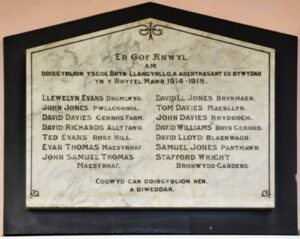
The Great War, 1914-1918
David Davies, Private, 38384, Welsh Regiment. David was the son of James and Anne Davies, of Gernos Farm, Maesllyn. During 1915 the family moved to Blaenglowan Fach, Talgarreg. David enlisted at Carmarthen into the Welsh Regiment, and landed in France on 16 December 1915, being posted to the 9th Battalion, Welsh Regiment, which was attached to 58 Brigade, 19th (Western) Division. The division was still in the Loos sector, and moved to the Somme early in 1916, where it was tasked with being the reserve division for the assault on Ovillers-La Boiselle on 1 July 1916. The division famously captured La Boiselle, and after a brief rest took part in the attack on Contalmaison on 7 July 1916. David was among 35 men killed during the attack by the 9th Welsh that day. He was 24 years old, and is commemorated on the Thiepval Memorial, France.
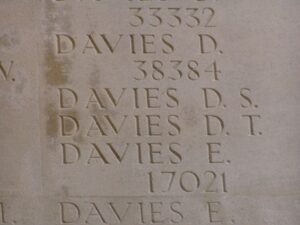
John Davies, Private, 90451, Machine Gun Corps. John was the son of Rees and Anne Davies, of Rhydgoch, Maesllyn, and the husband of Mary Davies, of Llethr Mawr, Maesllyn. He enlisted at Brecon into the South Wales Borderers, but was transferred to the 15th Company, Machine Gun Corps, which was attached to the 5th Division. John would have joined the Division early in 1917. John saw his first action at the Battle of Arras, fighting at the Battle of Vimy in April 1917, and the Third Battle of the Scarpe the following month. In September the Division moved to Ypres, and fought at the Battle of Polygon Wood, then at Broodseinde and Poelcappelle in September, and at the Second Battle of Passchendaele. The Division then briefly moved to Italy, before being hurriedly recalled to France in March 1918. John was killed almost as soon as the Division arrived back in France, on 28 March 1918. He was 23 years old, and is commemorated on the Arras Memorial, France.
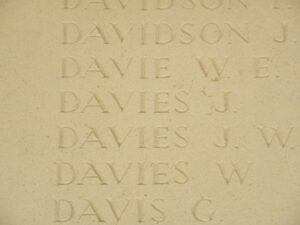
Tom Davies, Private, 201674, Welsh Regiment. Tom was the son of William and Sarah Davies, of Pwllglas, Llandyfriog, and formerly of Maesllyn. He served during the war with the 1st/6th Battalion, Welsh Regiment, which was the Pioneer Battalion to the 1st Division. The Division had been one of the first to arrive in France, fighting at the retreat from Mons to the Marne. They then fought at the Aisne, and at Chivy, before being moved north, and fought at the First Battle of Ypres. The following year saw them in action at the Battle of Aubers, and the Battle of Loos. During 1916 they fought during the Battle of the Somme. They followed the German retreat to the Hindenburg Line in early 1917, and later that year during the Second Battle of Passchendaele. After spending another Winter in Flanders, they were near Estaires when the German Spring Offensive caught them, before being moved South to Arras, fighting at the Battle of Drocourt-Queant, and at the Battle of Épehy. The Division pushed on towards the St. Quentin Canal, and after crossing the Hindenburg Line fought at the Battles of Beaurevoir, the Selle and the Sambre. Tom survived the war, but became ill and died on 2 December 1918, aged 27. He is buried at Premont British Cemetery, France. Tom is also commemorated at Bryngwenith Chapel, Henllan, and at Newcastle Emlyn.
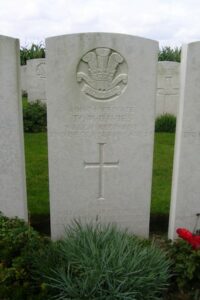
Tom Rees Davies, Lance Corporal, 7313, South African Infantry. Tom was the son of Rees and Maria Davies, of Ffoslas, Ffostrasol. He worked as a Carpenter prior to migrating to South Africa prior to the war. Tom enlisted into the 1st Regiment, South African Infantry, which was raised in Cape Province, joining the South African Infantry Brigade. In December 1915 the Brigade moved to Egypt, seeing action there against the Senussi tribesmen, before becoming transferred to France, joining the 9th (Scottish) Division. The Division then took part in the Battle of the Somme, fighting at the opening Battle of Albert, and then at the Battle of Bazentin, where they captured Longueval. They then fought at the Battle of Delville Wood, where the South Africans created a distinguished name for themselves. Tom was killed on the Somme on 18 October 1916. He was 33 years old, and is buried at Warlencourt British Cemetery, France. Tom is not named on the memorial, but was educated at the school.
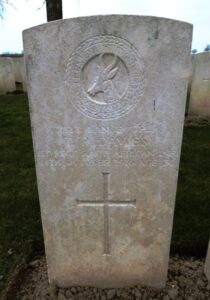
Regarding the following two men, Edward James Evans and Edward Lloyd Evans, the memorial shows Ted Evans, of Rose Hill (Rhos Hill?). Neither of these men has yet been traced to a home of that name, however it is more likely that Ted Evans was Edward Lloyd Evans, as he lived nearer to the school:
Edward James Evans, Private, 88425, Machine Gun Corps. Edward (Ted) was the son of Henry and Elizabeth Evans, of Pantywenol, Velindre. He enlisted in December 1916 into the 4th Welsh, and was posted to the 43rd Company, Machine Gun Corps, which was attached to the 14th (Light) Division. Edward landed in France on 6 May 1917, joining the Division at Ypres. The 20th Division took over the line from the 38th (Welsh) Division, and were tasked with the capture of the German positions around Langemarck. Ted was killed here on 22 August 1917. He was 22 years old, and is commemorated on the Tyne Cot Memorial, Belgium.
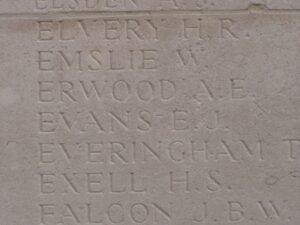
Edward Lloyd Evans, Private, 13059, Welsh Regiment. Edward was the son of Edward and Sarah Ann Evans, of Bryngwenith Chapel House. He enlisted at Carmarthen into the 9th Battalion, Welsh Regiment. The Battalion was attached to 58 Brigade, 19th (Western) Division, which crossed to France during July 1915, and fought during the opening attack of the Battle of Loos on 25 September. The Division suffered heavy casualties at Loos, and Edward was one of many men drafted into the 9th Welsh to rebuild its strength. During 1916 the division moved to the Somme, and took part in the second wave of the attack on Ovillers-La Boiselle on 1 July 1916 capturing the village at heavy cost. It remained on the Somme, and fought through the Somme Battles of Pozières and the Ancre in 1916. During 1917 the division moved to positions south of Ypres, and this is where Edward was killed in action on 3 May 1917. He was just 22 years old, and is buried at Vlamertinghe Military Cemetery, Belgium. Edward is also commemorated at Bryngwenith Chapel, Henllan.
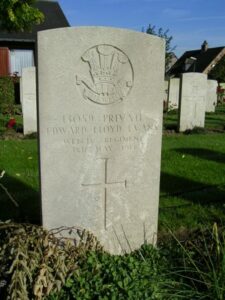
Llewellyn Evans, Lance Corporal, 136, Welsh Horse. Llewellyn was born at Cenarth in 1880, the son of David and Anne Evans. He married in 1904, and resided with his wife Mary Evans at 8, Railway Terrace, Henllan. Llewellyn was a veteran, who had served during the Boer War, and he enlisted at Henllan into the 1/1st Battalion, Welsh Horse Yeomanry, which was originally raised as a Welsh Cavalry unit. Around February 1915 the Welsh Horse joined the 1/1st Eastern Mounted Brigade, 1st Mounted Division in Woodbridge area, but in September 1915 dismounted and sailed from Liverpool in the SS Olympic on 25 September, landed at Anzac, where it became attached to the 54th (East Anglia) Division. The Welsh Horse were used as tunnellers on Gallipoli, and it was while working on a tunnel that Llewellyn was killed, when the Turks blew a mine on 20 November 1915. Llewellyn was buried at 7th Field Ambulance Cemetery, Gallipoli, alongside two of his comrades who died alongside him, Llewellyn Jones of Llangeler, and W.C. Lewis of Carmarthen.
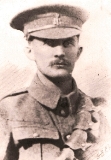
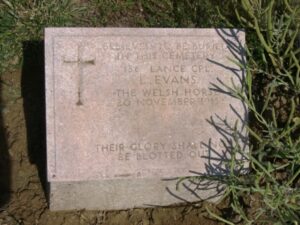
David Llewellyn Jones, Private, M2/181091, Army Service Corps. David was the son of William and Ann Jones, of Brynmaen, Llandyssul, and the Husband of Ada M. Jones (nee Thomas), of 5, Queen’s Road, New Tredegar, Monmouth. He enlisted at Bargoed into the Army Service Corps, and was posted to their 688th M.T. Company, which was stationed in Salonika. David died in Macedonia on 1 November 1918, aged 30, and is buried at Skopje British Cemetery, Macedonia.
John Jones, Private, 12902, Royal Welsh Fusiliers. John was the son of Mrs. Anne Jones, of Pwllcornol Isaf, Penrhiwllan. He enlisted at Ammanford into the 9th Battalion, Royal Welsh Fusiliers, which was attached to 58 Brigade, 19th (Western) Division. John landed in France with the battalion on 19 July 1915, and moved to positions near Festubert, where it was initiated into trench warfare. The Division took part in the opening attack of the Battle of Loos on 25 September 1915. John became one of hundreds of men of the 19th Division killed that day, during a futile diversionary attack near Festubert. He was 22 years old, and is commemorated on the Loos Memorial, France.
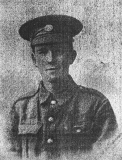
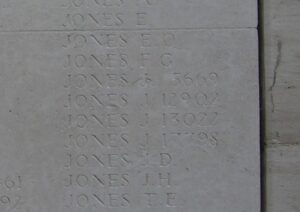
Samuel Jones, Private, M/5422, Royal Army Service Corps. Samuel was born at Penrhiwllan in 1890, the son of John and Ann Jones, of Pantmawr. Prior to the war he resided with his wife, Minnie L. M. Jones, at Brynivor, Horeb, Llandyssul. Samuel had been an early enlistee into the army, and had landed in France on 7 October 1914, serving with the Army Service Corps. He served in France for the duration of the war, but died in hospital at Chester, soon after demobilisation, on 7 March 1919. Samuel was 29 years old, and is buried at Gwernllwyn Congregational Chapelyard.
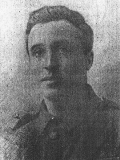
David Lloyd, Stoker 2nd Class, K/53121, Royal Navy. David was born on 20 March 1892, the son of James and Ann Lloyd, of Blaenwaun, Maesllyn, and the husband of Elizabeth Lloyd, of Yetgoch, Maesllyn. He enlisted into the Royal Navy on 13 August 1918 and was posted to HMS Vivid II, the Royal Naval Establishment at Plymouth. David became ill soon afterwards and died at Plymouth Hospital of pneumonia on 11 September 1918. He was 26 years old, and is buried at Bwlchygroes Independent Chapelyard.
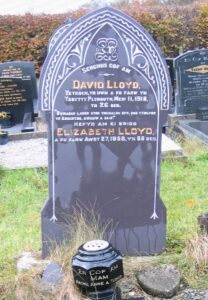
David Richards, Private, 16642, Royal Welsh Fusiliers. David was born at Alltfawr, Aberbanc, the son of Henry and Nancy Richards. He enlisted at Bronwydd into the 13th Battalion, Royal Welsh Fusiliers, which was attached to 113 Brigade, 38th (Welsh) Division. On 2 December 1915 the battalion moved to France, and the entire Division moved to the Fleurbaix sector, where it was initiated into trench warfare. During June 1916 the Division marched south to the Somme, and on 7 July 1916 attacked Mametz Wood. The initial attack failed, and it was three days later, on 10 July, that a fresh attack was mounted. After two days of heavy hand to hand fighting within the wood, the Germans withdrew, and the battered Welshmen moved via Hébuterne to Boesinghe, on the Yser Canal. David was badly wounded at Ypres on 1 July 1917, and died of his wounds late that day at the Casualty Clearing Station at Proven, aged 26. He is buried at Mendinghem Military Cemetery, Belgium.

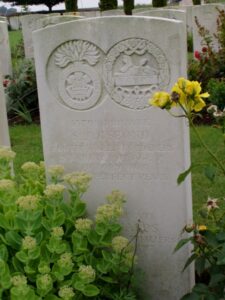
Evan Thomas, Private, 27303, South Wales Borderers. Evan was the son of Elias and Anne Thomas, of Maesyrhaf, Maesllyn. He enlisted at Newport, Monmouth into the 3rd Battalion, South Wales Borderers. Evan didn’t get posted overseas, but died on home service on 25 July 1916. He was 20 years old, and is buried at Bwlchygroes Independent Chapelyard. His brother John also fell.
John Samuel Thomas, Private, 359389, Labour Corps. John was the son of Elias and Anne Thomas, of Maesyrhaf, Maesllyn. He enlisted at Llandyssul into the Pembroke Yeomanry. He later transferred to the Royal Welsh Fusiliers, and served with their 1/5th Battalion for a while, before being transferred to the 805th Employment Company, Labour Corps. This Company served with the Western Frontier Force, and John died of sickness while serving with them on 9 September 1918. He was 26 years old and is buried at Kantara War Memorial Cemetery, Egypt. His brother Evan also fell.
David Thomas Williams, Stoker 2nd Class, K/44598 (Dev), Royal Navy. David was born on 30 November 1898, the son of Thomas and Anne Williams, of Bryn Gernos, Maesllyn. He had worked as a Blacksmith’s Striker prior to enlisting into the Royal Navy on 26 July 1917, and was posted to HMS Vivid, the Royal Naval Establishment at Portsmouth. David died in hospital at Plymouth of tuberculosis and peritonitis on 7 November 1917, aged 18, and is buried at Bwlchygroes Independent Chapelyard.
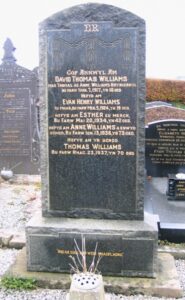
Joshua Douglas Stafford Wright, Guardsman, 19646, Grenadier Guards. Stafford was born in 1894, the son of George and Sarah Wright, of Bronwydd Gardens, Llangynllo. He was a Grocer at Swansea prior to the war, and enlisted there on 5 October 1914 into the 4th Battalion, Grenadier Guards. Stafford joined his battalion at the Guards Depot at Caterham, but was found to be unfit for military service, and was discharged as medically unfit on 14 October 1914. He returned to Swansea, and enlisted into the Royal Navy. Stafford served for the rest of the war with the Royal Navy, and after being discharged returned to Swansea, and became a Policeman. He had only been in the force a month before he became ill, and died there of pneumonia on 26 February 1919, aged 24. He was buried in Sketty Churchyard. Stafford is not commemorated by the CWGC as he was not a war casualty.